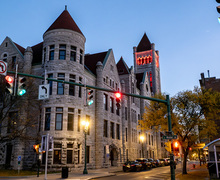The medieval history behind caps and gowns
Logan Reidsma | Senior Staff Photographer
Decorating caps puts a modern spin on the centuries-old graduation tradition.
Students gathered together in long, multicolored robes could only mean one of two things: they are students at Hogwarts School of Witchcraft & Wizardry or they’re graduating.
The tradition of wearing the long, flowing robes began in the Middle Ages, at the time universities were first created, said Samantha Herrick, an associate professor of history in the Maxwell School of Citizenship and Public Affairs who specializes in medieval European history.
When universities were founded in the mid-12th–13th centuries, the standard uniform was a long, heavy robe. This attire was worn for several reasons — it was culturally normalized because the students at the time were training to be members of the clergy, and robes were also a practical choice in cold weather, Herrick said.
The hoods, which are a part of many graduation gowns, originated out of practicality during the Middle Ages, as well, Herrick said. Many of the priests and monks at the time had short haircuts, particularly monks who had the tops of their head shaven. Hoods were necessary to protect their heads from the cold.
Academic dress became increasingly popularized during the reign of Henry VIII of England when it was decided that students at the University of Oxford and the University of Cambridge would be required to wear it in an effort to look scholarly and somber. Students at these universities still must wear academic regalia at various occasions throughout the academic year, Herrick said.
However, it wasn’t until several hundred years after, in the late 19th century, that the U.S. decided to pick up the traditional style for graduation ceremonies. At that time, Herrick said, the U.S. also began the tradition of assigning specific color gowns to disciplines, and types of gowns to types of degrees.
As a historian, Herrick said she is most interested in how universities today, which are institutions of medieval society, are shaped by their roots.
“The idea was simply that universities traced their roots back to medieval times —
wouldn’t it be cool to recognize that by dressing like this?” Herrick said.
She compared the dress for graduation to the clothing people wear at weddings. At each, people dress differently than they would normally to signal the importance of the event. She said this type of attire feels special because it ties academia and education back to something sacred and ancient.
“We like to mark this as an occasion that’s really different. For a student it’s a really big deal,” Herrick said. “You’re entering a new part of your life.”
Published on May 9, 2016 at 12:40 pm
Contact Alex: aerdekia@syr.edu





